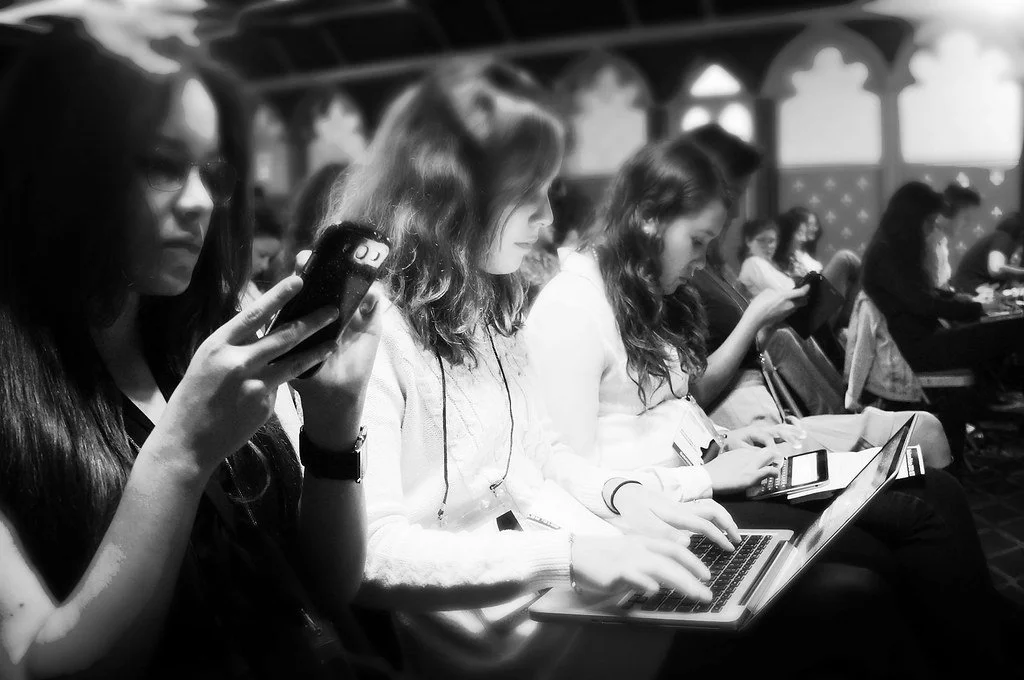Gamification and Dating Apps V2.0
It’s a Wednesday night. You’re trying your best to give season 7 of Brooklyn Nine-Nine the respect it deserves, but your attention is divided by…
Tom, 31, Architect, 8km away, likes Radiohead, but owns nothing but active wear. We get it mate, you’re on the shred and enjoy #healthyliving. LEFT.
Andrew, 30, Teacher, 5km away, great facial hair, but doesn’t like cats? We all know anti-animal sentiment is the gateway drug for sociopaths. LEFT.
Zac, 35, Bartender, 15km away, claims to always share his hot chippies, and has encyclopedic knowledge of gin. Well, well, well… a gentleman and a scholar. RIGHT.
IT’S A MATCH! Better keep swiping though…
Eggplant or Love by Tanya Zerek
If this scenario is a little too familiar, don’t worry. You’re not alone. According to Survey Monkey (2021:para.4) a third of adults aged 18-44 years have used an online dating app. Of this figure, more than half view dating apps in a negative light, yet continue to use them in the quest for love, sex, companionship, friendship…
So, why can’t we break up with dating apps?
Rather than lead you on, I’ll be upfront: gamification. Gamification involves the use of game design, game thinking, and game elements to improve motivation and engagement (Dicheva et al. 2015:75). It is ultimately a means of replicating the kinds of physiological effects often seen in game contexts, in non-game contexts.
The rush of dopamine you get when “it’s a score”… I mean… “match”. The hours spent meticulously designing your avatar… I mean… profile. The anxiety you feel when deciding to quit the game… I mean… uninstall the app.
Although gamification is still in its infancy, it is flirting with the nexus position between tech developers and profit, due to its ability to engage consumers and achieve customer loyalty (Bohyun 2015:6).
Dating apps are the perfect proving grounds to test the ethical parameters of gamification, given we ‘will do anything for love’…right? Not quite. Just as Meatloaf had his limits, so too do consumers who are left feeling cheated by the heavily gamified and superficial design of the original dating apps.
Maybe it’s time we start seeing other dating apps…
That is the proposition of tech developer Alex Durrant, Jigsaw CEO and co-founder. Jigsaw is a dating app using gamified design techniques to encourage users to get to know their matches personalities before their appearance is revealed – piece by piece – behind a jigsaw puzzle. Yep, the clue is in the name…
If you’re not convinced Jigsaw will break the cycle of the infinite scroll, check out the innovative dating app Thursday from London based tech developer George Rawlings. Marketed under the tongue-in-check tagline ‘the dating app that doesn’t work 85.7% of the time’, Thursday only operates on one day a week (Pantony 2021:para.4). Once again, the clue is in the name. This gives consumers a six-day gamification/dating app detox, and a chance to focus on human connection.
When it comes to dating, chances are we didn’t get it right the first time. And the same principle applies to the industry of dating apps. The initial wave of dating apps were overzealous in their application of gamification. This has led to ethical problems like hyper-engagement and tech addiction, and it’s no surprise consumers are saying “we need to talk”.
Gamification ultimately requires a deeper understanding of the user, context, and behaviour (Morschheuser et al. 2017:13). So the trend of new tech developers in the dating app industry listening, and acting on consumer feedback is a positive step in the ethical direction.
Sunset by Tanya Zerek, 30 April 2021. Made with Canva
The era of dating apps V1.0 is over. Gamification is evolving in the industry, and V2.0 is characterised by a measured approach that considers an ethical balance between profit and a positive user experience.
So, perhaps the right one is out there after all.
In the meantime, I’m off to share a bowl of hot chippies and a G&T with Zac, 35, Bartender, 15kms away...
References
Bouyon K (2015) ‘The popularity of gamification in the mobile and social era’, Library Technology Reports, 51(2):5-9, accessed 27 April 2021.
Cheddar Now (7 November 2020) ‘Jigsaw Dating App Focuses On Conversation Over Selfies’ , Cheddar Now, YouTube, accessed 30 April 2021.
Dicheva D, Dichev C, Agre G and Angelova G (2015), ‘Gamification in education: A systematic mapping study’, Journal of Educational Technology & Society, 18:75-88, accessed 28 April 2020.
Eggplant or Love by Tanya Zerek, 30 April 2021. Made with Canva
Messaging by Tanya Zerek, 30 April 2021. Made with Canva
Morschheuser B, Hassan L, Werder K, Hamari J (2017), ‘How to design gamification? A method for engineering gamified software’, Information and Software Technology, 95(?):219-237, https://doi.org/10.1016/j.infsof.2017.10.015
SurveyMonkey (n.d.) Dating apps are common, useful—and widely disliked, SurveyMonkey, accessed 28 April 2021.
Pantony A (20 April 2021) ‘Spend too much time mindlessly swiping on dating apps? Thursday is the brand new app to help you find love – and it only works on one day of the week…’, Glamour Magazine, accessed 28 April 2021.
Sunset by Tanya Zerek, 30 April 2021. Made with Canva
Gamification, Pointification and… Cadbury Favourites?
There it was. On public display. For all to see.
As he manoeuvred through the labyrinth of limbs, he caught the occasional soundbite above the hum of anxious students: “Yessss, 92!” – “I got 91!” – “Jessica, shut uuuuup, you got 96!”. Well, how grand life must be in the upper 10th percentile, he thought. Then just as the heel of Brad Schoefield’s shoe sank into his toes, there it was. 57%. He couldn’t decide what hurt more. The imminent “thanks for trying, here’s your participation award”, or 110kgs of Brad Schoefield. As the chorus of excited upper 10th percentile’s grew louder… he decided it was the former.
We’ve all been there before: the publicly broadcast leader board.
For a few, it’s a moment of immense pride. For some, it triggers a desire to do better. And for others, it’s simply humiliating.
The use of gamified elements in educational contexts is not a new concept. We’ve been using leader boards, points, gold stars, badges, and giving chocolate bars as rewards for decades. We seldom stop to question their place in the classroom, because, hey… if you’ve got a cheeky Cadbury Favourite coming your way, you’re hardly going to complain right?
However, with the rise of digital media, the use and application of gamified elements to engage and motivate is increasing rapidly. This has been facilitated by the ease with which digital interfaces can be gamified (Bohyn 2015:8).
For example:
Minecraft: Education Edition allows educators to deliver lessons in a digital environment promoting creativity, collaboration, and problem-solving.
Archie Learning allows educators to curate digital platforms and design a gamified one-stop-shop learning experience.
Duolingo allows users to learn new languages at their own pace, through a free, gamified app.
While these programs are having positive effects on student learning, it is important to highlight their construction is informed by user experience, design, and motivational theory experts.
The danger in applying gamification techniques in educational contexts where these resources are not available, is ending up with a crude subsidiary of gamification. This is better known as pointification and has adverse effects on student learning (Van Roy and Zaman 2017:4).
So, does this mean educators should scrap the box of Cadbury Favourites unless they have a PHD in Psychology and Behavioural Science? No. Let’s not do anything drastic here… we love our choccies.
It just means educators need to be strategic in their use of gamification, and adapt their approach when they sense their students are not responding.
Gamification is not a ‘one size fits all’ approach. While the upper 10th percentiles might enjoy a Turkish Delight, the 57%ers might prefer a Crunchie…
References:
Bouyon K (2015) ‘The popularity of gamification in the mobile and social era’, Library Technology Reports, 51(2):5-9, accessed 27 April 2021.
Exam Results by Tanya Zerek, 29 April 2021. Made with Canva.
Van Roy R and Zaman B (2017) ‘Why gamification fails in education and how to make it successful: introducing nine gamification heuristics based on self-determination theory’, in Ma M and Oikonomou A (eds) Serious games and edutainment applications, Springer-Verlag, Switzerland.
Fitness, Gamification and Audio
It all begins with an idea.
It’s a 5.30am winter morning in Melbourne. You hesitantly poke your toes out from beneath the blanket and just as you suspected, it’s bloody freezing! “Why didn’t I move to the Sunshine Coast like every other f**ker did during lockdown?” you mutter into the pillow. 5km run, snuggly warm bed, 5km run, snuggly warm bed, 5km run. You repeat the tribal mantra as though repetition will somehow summon the ‘God of Motivation’… who is currently on holiday, probably in the Sunshine Coast. Lucky bastard.
If your motivation to stay in a snuggly warm bed trumped your motivation to go for a run:
A. We’re kindred spirits
B. You might benefit from the use of a gamified fitness app
The premise of gamified fitness app’s is simple: to engage, motivate, and make exercise fun! In other words, a gameful experience is designed to bridge the gap between a 5.30am winter morning in Melbourne, and strapping on your sneakers to smash out 5kms.
Like me, you may have approached the use of gamified apps with a hint of apprehension in the past. You may have found gamified elements like points and badges gimmicky, and ultimately unsuccessful in tapping into that deeper level of your psyche. This feeling is backed by research suggesting today’s fitness app’s do not adequately consider behaviour change theory in gamified design (Cotton and Patel 2019:450).
This is where narrative gamification, and audio comes in!
Before we became enchanted by the power of the moving image – ”oh look at all the pretty colours” – there was sound. Vibrations in the air, delivered via a medium, and registered physically as these vibrations pass through our ear canals.
In 1938, Orson Welles broadcast a radio adaptation of H.G. Wells fictitious tale of martian invasion, War of the Worlds. The audio was so compelling and felt so viscerally, a panic erupted as listeners struggled to distinguish the narrative from reality.
Although the appetite for audio as a stand-alone media output began to wane, we came full circle thanks to the rise of digital media. The clutter of visual material we experience daily has resulted in hyper-stimulation. And as a result, stand-alone sensory experiences have once again become palatable. Think digital radio, podcasts, audio books, audio dramas…
And on the eve of this movement came the global pandemic and a chorus of “oh… well… I may as well get fit during lockdown”. Enter Zombies Run, the digital era’s answer to: War of the Worlds.
The advantage Zombies Run has over War of the Worlds is the widespread adoption of the smartphone, mobile web, and GPS tracking (Bohyun 2015:8). This provides users with an immersive experience where they become part of the narrative, rather than passive listeners.
The use of narrative in digital applications signals a transcendence to a more sophisticated use of gamification techniques. So, if points and badges leave you feeling like the game is playing you, give Zombies Run a try and see the difference when you ARE the game.
It might just get you out of bed on a 5.30am winter morning in Melbourne…
References:
Bohyun K (2015) ‘The popularity of gamification in the mobile and social era’, Library Technology Reports, 51(2):5-9, accessed 27 April 2021.
Cotton V and Patel MS (2019) ‘Gamification use and design in popular health and fitness mobile applications’, American Journal of Health Promotion, 33(3)448-451, https://doi.org/10.1177/0890117118790394
Person Wearing Brown Bubble Jacket by Burst, (Public Domain)
Citizen journalists and bloggers: stealing from the rich to give to the poor?
It all begins with an idea.
There was a time, long ago, when newspapers reigned supreme.
A plentiful supply of classified advertising revenue meant newspaper profits ran like rivers of gold.
None enjoyed the splendour of these prosperous times quite like the evil king Murdoch, whose sovereignty dared not be questioned in the kingdom of media.
Until the citizen journalist and their band of merrie bloggers arrived…
The media landscape and the nature of journalism is changing.
New online platforms and digital participatory culture is having unprecedented effects on the way news is produced and consumed.
This shift to ‘digital’ is reinforced by an acceleration in ecommerce due to the Covid-19 pandemic.
As a result, our lives are now taking place online and so too is journalism.
Some argue notions of journalism are intrinsically linked with democracy, and therefore the emergence of citizen journalists and bloggers is simply a self-fulfilling prophecy.
Yes, diversity of opinion is important.
However, the shift to ‘digital’ has left media outlets unable to monetise their greatest commodity.
Because, “why pay for news when you can get it for free” right?
Wrong.
With a platform and opinion comes a sense of responsibility to share information ethically.
Some lines should not be crossed, and the journalism profession knows this.
Unfortunately, some (not all) citizen journalists and bloggers do not.
So, are citizen journalists and bloggers stealing from the rich to give to the poor?
No. The media landscape and media economy has changed.
But the Covid-19 pandemic has shown us that we should be prepared to pay for accuracy, integrity and responsible news reporting.
Because there is value in the journalism profession.





